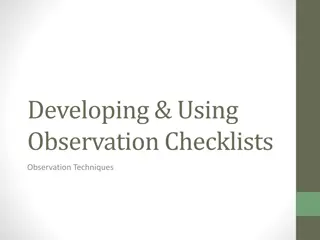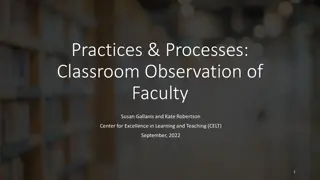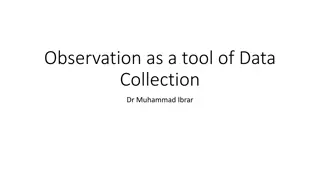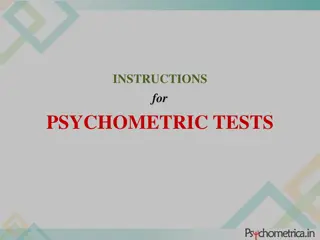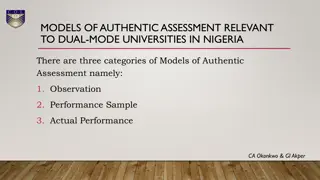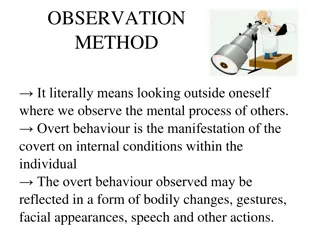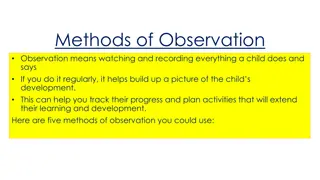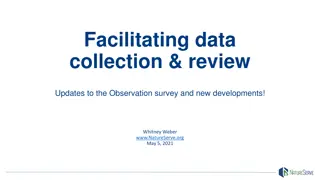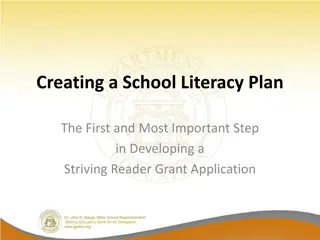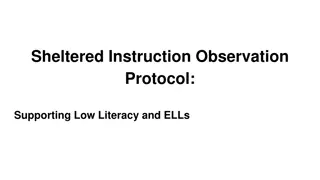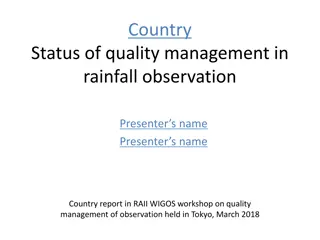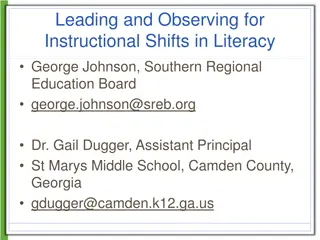Effective Literacy Instruction Observation Guide
Conducting a substantial observation of literacy instruction involves looking at decoding, vocabulary, fluency, comprehension, and writing lessons, while considering time allocation, student engagement, and quality standards. Emphasizing 2-3 hours of daily literacy instruction spread throughout the day, efficiency and active student participation are key factors in ensuring effective learning outcomes.
Download Presentation

Please find below an Image/Link to download the presentation.
The content on the website is provided AS IS for your information and personal use only. It may not be sold, licensed, or shared on other websites without obtaining consent from the author.If you encounter any issues during the download, it is possible that the publisher has removed the file from their server.
You are allowed to download the files provided on this website for personal or commercial use, subject to the condition that they are used lawfully. All files are the property of their respective owners.
The content on the website is provided AS IS for your information and personal use only. It may not be sold, licensed, or shared on other websites without obtaining consent from the author.
E N D
Presentation Transcript
Reading/Writing Observation Guide Timothy Shanahan University of Illinois at Chicago www.shanahanonliteracy
General Overview To conduct a substantial observation of literacy instruction it is necessary to look at particular kinds of lessons (decoding, vocabulary, oral reading fluency, reading comprehension, writing) Each of those lesson types has its own purposes and its own standards of quality But there are general issues about literacy instruction that need to be determined as well (e.g., time issues, environment)
Time and Content Coverage Amount of instruction is one of the two most powerful determinants of learning (along with curriculum coverage) Instructional time includes time devoted to any activity with a reasonable possibility of contributing to literacy learning (including teacher presentation/explanation, guided student practice of reading or writing, teacher feedback, independent practice, discussion) I require 2-3 hours per day of literacy instruction (throughout the day)
Time and Content Coverage (cont.) Instructional time in literacy needs to be divided among: word knowledge, fluency, comprehension, and writing Not all instructional activities are of equal value so efficiency matters, too No matter how well conceived an instructional activity, if all students are not actively engaged in it learning is not likely to be the result
1. Overall amount of literacy instruction How to Determine ? Purpose Provide adequate amount of literacy instruction
1. Overall amount of literacy instruction (cont.) How to Determine Purpose Provide adequate amount of literacy instruction
1. Overall amount of literacy instruction (cont.) How to Determine Examination of lesson plans Several brief observations throughout day (dip ins) Discussion with teacher Purpose Provide adequate amount of literacy instruction
2. Sufficient time for each component How to Determine ? Purpose Sufficient time is devoted to each major component of literacy
Word Knowledge Word Knowledge includes lessons on letter names, phonological awareness, decoding/spelling, high frequency words, vocabulary, structural analysis (morphology) Word instruction focuses student attention on individual words or parts of words (separate from text) Its purpose is to increase student ability to read/decode or spell words and their knowledge of word meanings
Oral Reading Fluency Oral reading fluency refers to the ability to read text accurately, with appropriate rate, and with appropriate expression Oral reading fluency instruction includes oral reading practice (with repetition) and explanation/discussion/analysis of texts aimed at enhancing oral reading It does not include round robin reading (one child reading while everyone else listens)
Reading Comprehension Reading comprehension refers to extracting or constructing meaning through the reading of a text Reading comprehension instruction includes guided reading of text, explanation/practice with comprehension strategies, activities/exercises aimed at figuring out the meaning of text Student reading time counts, but only if the teacher provides some specific guidance/preparation for reading and/or accountability for the reading Can be listening comprehension activities with non- or beginning-readers or when used as a specific model for the students own reading
Writing Writing refers to communicating meaningful information through extended written language Writing instruction includes teaching students to print, kyeyboard or use cursive to write messages; engaging students in the writing process (prewriting, drafting, revising, editing); explaining or showing students how to write Copying text (except for brief periods of handwriting or printing practice) or writing brief answers do not count as writing
2. Sufficient time for each component How to Determine ? Purpose Sufficient time devoted to each major component of literacy
2. Sufficient time for each component (cont.) How to Determine Purpose Sufficient time devoted to each major component of literacy
2. Sufficient time for each component (cont.) How to Determine Examination of lesson plans Several brief observations throughout day (dips) Discussion with teacher Purpose Teacher provides adequate amount of literacy instruction
3. Lesson well prepared How to Determine ? Purpose Lesson is well planned all needed materials are available and interruptions and delays are minimized
3. Lesson well prepared (cont.) How to Determine Purpose Lesson is well planned all needed materials are available and interruptions and delays are minimized
3. Lesson well prepared (cont.) How to Determine Are all materials available? Are likely problems anticipated/minimized? Is there an effective scheme in place to minimize interruptions (particularly for small group instruction)? Purpose Lesson is well planned all needed materials are available and interruptions and delays are minimized
4. Instruction is organized efficiently (cont.) How to Determine ? Purpose Instruction is organized efficiently
4. Instruction is organized efficiently (cont.) How to Determine Purpose Instruction is organized efficiently
4. Instruction is organized efficiently (cont.) How to Determine Are students grouped appropriately for the teaching (whole class, small group, individual)? Is the instruction unnecessarily repetitive? Are transitions quick and smooth? Purpose Instruction is organized efficiently
5. Students are on task How to Determine ? Purpose Students are attentive and on task
5. Students are on task How to Determine Purpose Students are attentive and on task
5. Students are on task How to Determine Wait for lesson to begin Count the number of students who appear to be doing what they are supposed to Calculate the proportion Do multiple times throughout a lesson Purpose Students are attentive and on task
6. Students are engaged in learning How to Determine ? Purpose Students are engaged in learning not just doing activities
6. Students are engaged in learning How to Determine Purpose Students are engaged in learning not just doing activities
6. Students are engaged in learning How to Determine Learning purpose of lesson is explained (observed) Teacher knows the purpose of the lesson (observed, ask them) Students know what they are learning (ask them) The match of purpose to activity is reasonable Purpose Students are engaged in learnin--not just doing activities
7. Lots of opportunities for individual response How to Determine ? Purpose Students need opportunities to respond and interact Opportunities to read, write, spell, reply, question, and other interaction loops are important to learning
7. Lots of opportunities for individual response How to Determine Purpose Students need opportunities to respond and interact Opportunities to read, write, spell, reply, question, and other interaction loops are important to learning
7. Lots of opportunities for individual response How to Determine Observations How many students get to respond? How much interaction does a response require? Purpose Students need opportunities to respond and interact Opportunities to read, write, spell, reply, question, and other interaction loops are important to learning
8. Lessons are paced appropriately How to Determine ? Purpose Lessons are paced appropriately neither hurried, nor tedious
8. Lessons are paced appropriately How to Determine Purpose Lessons are paced appropriately neither hurried, nor tedious
8. Lessons are paced appropriately How to Determine Watch student reactions to the lesson are they bored or getting antsy? Does the activity change often enough to prevent monotony? Purpose Lessons are paced appropriately neither hurried, nor tedious
9. Students can self assess How to Determine ? Purpose Students are provided with data on which to evaluate themselves
9. Students can self assess How to Determine Purpose Students are provided with data on which to evaluate themselves
9. Students can self assess How to Determine What kind of feedback does the teacher provide? Are there opportunities for kids to check their own progress (e.g., word cards, writing folder reviews, oral reading fluency charting) Purpose Students have a clear idea of their own progress/success in learning
Word Knowledge One quarter of the instructional time devoted to reading should be devoted to teaching students about words. Word knowledge instruction includes teaching students to recognize (decode) words or (or parts of words) or to understand word meanings. Most word recognition (decoding) instruction should take place in the primary grades and with older students who are struggling with these skills. Most formal word meaning instruction takes place after students complete second grade. (Lots of informal attention to word meanings before that.) Research evidence is clear that students read better if they receive instruction in phonemic awareness, phonics, and vocabulary so there is no excuse for not teaching these to children.
Phonological Awareness Instruction Phonological awareness (PA) refers to the ability to hear and manipulate the sounds of language (separate from meaning). It includes phonemic awareness which refers to the ability to hear and manipulate the separable sounds (phonemes) within words. For example, to hear the 3 distinct sounds in a word like cat, you must have phonemic awareness. Phonemic awareness instruction should be completed for most children during kindergarten and first grade. The average child needs about 14-18 hours of PA instruction to do well, but some kids need more and some less. 18 hours is approximately 15 minutes per day for a semester. Teachers should work on PA until their children are able to fully segment words (that is they should be able to divide simple words into each separate phoneme: /c/ /a/ /t/ and to hold this information in memory well enough to manipulate these sounds (blending them into words, deleting them, substituting them, etc.) The children should be learning their letters and letter names during the period when they are being taught PA.
PA1. Focused on sounds within words. How to Determine Observe instruction (is the instruction focused on hearing syllables, onset-rimes, phonemes in words) Examine the curriculum being followed Purpose PA instruction is aimed at getting kids to perceive the sounds within words, instruction needs to emphasize developing this ability
PA2. Letter names. How to Determine Observation (are students being taught to recognize and name individual upper and lower case letters) Examine curriculum being used Talk to teacher Purpose Teaching letter names along with PA increases the impact of PA instruction
PA3. Instruction is brief and purposeful. How to Determine Observe lesson and time it Do dip in observations to determine length Examine lesson plan Observe lesson and try to determine purpose (match with lesson plan) Purpose Effective PA instruction should be limited to about 15 mins at a time Purpose of the instruction should be clear
PA4. Classroom quiet during PA work. How to Determine Is instruction organized so that students can hear the sounds clearly? If the class gets noisy during lesson, does teacher quiet it down rather than competing with the noise? Purpose Perceiving sounds by ear depends upon being able to hear the sounds clearly
PA5. Seeing the pronunciations. How to Determine Is instruction organized so that children can see teacher s mouth when presenting items? Does teacher direct students to watch pronunciation? Does teacher bring attention to how word is pronounced? Purpose Seeing articulation is an important part of hearing phonemes accurately
PA6. Follows a systematic sequence. How to Determine Examine lesson plans Examine curriculum Observe to see how instruction matches curriculum Discuss with teacher Purpose Learning PA proceeds from gross sounds to finer sounds Words, rhymes, syllables, onset-rimes, beginnings, endings, medials, deletion, blending, segmentation
PA7. Keep it simple1 or 2 skills. How to Determine Observe lesson Examine lesson plan Purpose Students do best with PA when instruction is limited to 1 or 2 skills per lesson Matching, isolation, substitutions, deleting, blending, segmentation
PA8. Concrete way to match phonemes. How to Determine Observe lesson Examine lesson plan Purpose Sounds can be abstract, so provide kids with concrete ways of counting and matching letters Chips, letter cards
PA9. Keep it motivating. How to Determine Observe lesson Examine lesson plan Are kids engaged? Purpose Use songs, chants, word games Be enthusiastic during instruction
PA9. Monitoring and reteaching. How to Determine Discuss with teacher Purpose Important not to let kids falls behind Need a plan for monitoring student progress with PA Need a plan for reteaching PA
Phonics/Decoding Phonics refers to understanding the relations between letters and sounds, and knowing how to use this information to recognize or spell words. Phonics instruction should be completed for most children during kindergarten, first, and second grade (may go on longer if kids are struggling). When children can decode (sound out) most words they have had enough phonics instruction. Phonics can be combined with spelling instruction.
Phonics/Decoding (cont.) Phonics should teach students the sounds associated with common letters or letter combinations (B = /b/; sh= /sh/; etc.). Phonics should teach students how to pronounce and spell common spelling patterns (-ight; -ame; -ough; etc.)




